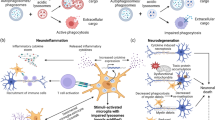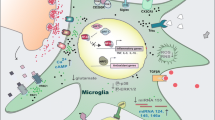Abstract
Microglia, as innate immune cells in the brain, closely monitor changes in the internal environment and participate in the maintenance of homeostasis in the central nervous system (CNS). Microglia can be polarized to the M1 or M2 phenotype in response to various stimuli in vivo or in vitro, affecting the functions of peripheral neurons. M2 microglia have attracted increasing attention in recent years owing to their beneficial effects on various diseases and injuries of the CNS, such as traumatic brain injury, stroke, Alzheimer’s disease and multiple sclerosis. They exert neuroprotective effects by various mechanisms, e.g., suppressing inflammation, promoting the degradation of misfolded and aggregated proteins, promoting neurite growth, enhancing neurogenesis, inhibiting autophagy and apoptosis, promoting myelination, maintaining blood–brain barrier integrity, and enhancing phagocytic activity.This review summarizes the molecular mechanisms by which M2 microglia exert protective effects on neurons and provides a reference for the selection of therapeutic targets for CNS diseases.

Similar content being viewed by others
References
Zhang J, Li S, Li L, Li M, Guo C, Yao J, Mi S (2015) Exosome and exosomal microRNA: trafficking, sorting, and function. Genomics Proteom Bioinf 13:17–24. https://doi.org/10.1016/j.gpb.2015.02.001
Schultzberg M, Lindberg C, Aronsson AF, Hjorth E, Spulber SD, Oprica M (2007) Inflammation in the nervous system–physiological and pathophysiological aspects. Physiol Behav 92:121–128. https://doi.org/10.1016/j.physbeh.2007.05.050
Tohidpour A, Morgun AV, Boitsova EB, Malinovskaya NA, Martynova GP, Khilazheva ED, Kopylevich NV, Gertsog GE, Salmina AB (2017) Neuroinflammation and Infection: Molecular Mechanisms Associated with Dysfunction of Neurovascular Unit. Front Cell Infect Microbiol 7:276. https://doi.org/10.3389/fcimb.2017.00276
Salter MW, Stevens B (2017) Microglia emerge as central players in brain disease. Nat Med 23:1018–1027. https://doi.org/10.1038/nm.4397
Qin C, Zhou LQ, Ma XT, Hu ZW, Yang S, Chen M, Bosco DB, Wu LJ, Tian DS (2019) Dual Functions of Microglia in Ischemic Stroke. Neurosci Bull 35:921–933. https://doi.org/10.1007/s12264-019-00388-3
Wolf SA, Boddeke HW, Kettenmann H (2017) Microglia in Physiology and Disease. Annu Rev Physiol 79:619–643. https://doi.org/10.1146/annurev-physiol-022516-034406
Orihuela R, McPherson CA, Harry GJ (2016) Microglial M1/M2 polarization and metabolic states. Br J Pharmacol 173:649–665. https://doi.org/10.1111/bph.13139
Walker DG, Lue LF (2015) Immune phenotypes of microglia in human neurodegenerative disease: challenges to detecting microglial polarization in human brains. Alzheimers Res Ther 7:56. https://doi.org/10.1186/s13195-015-0139-9
Wang Y, Huang Y, Xu Y, Ruan W, Wang H, Zhang Y, Saavedra JM, Zhang L, Huang Z, Pang T (2018) A Dual AMPK/Nrf2 Activator Reduces Brain Inflammation After Stroke by Enhancing Microglia M2 Polarization. Antioxid Redox Signal 28:141–163. https://doi.org/10.1089/ars.2017.7003
Wen L, You W, Wang H, Meng Y, Feng J, Yang X (2018) Polarization of Microglia to the M2 Phenotype in a Peroxisome Proliferator-Activated Receptor Gamma–Dependent Manner Attenuates Axonal Injury Induced by Traumatic Brain Injury in Mice. J Neurotrauma 35:2330–2340. https://doi.org/10.1089/neu.2017.5540
Namjoshi DR, Martin G, Donkin J, Wilkinson A, Stukas S, Fan J, Carr M, Tabarestani S, Wuerth K, Hancock RE, Wellington CL (2013) The liver X receptor agonist GW3965 improves recovery from mild repetitive traumatic brain injury in mice partly through apolipoprotein E. PLoS ONE 8:e53529. https://doi.org/10.1371/journal.pone.0053529
Hou K, Xu D, Li F, Chen S, Li Y (2019) The progress of neuronal autophagy in cerebral ischemia stroke: Mechanisms, roles and research methods. J Neurol Sci 400:72–82. https://doi.org/10.1016/j.jns.2019.03.015
Tavernarakis N (2020) Regulation and Roles of Autophagy in the Brain. In. Springer International Publishing, Cham, pp 33–33. https://doi.org/10.1007/978-3-030-32633-3_5
Min JW, Lu L, Freeling JL, Martin DS, Wang H (2017) USP14 inhibitor attenuates cerebral ischemia/reperfusion-induced neuronal injury in mice. J Neurochem 140:826–833. https://doi.org/10.1111/jnc.13941
Kalluri R, LeBleu VS (2020) The biology, function, and biomedical applications of exosomes. Sci 367. https://doi.org/10.1126/science.aau6977
Blennow K, Hardy J, Zetterberg H (2012) The neuropathology and neurobiology of traumatic brain injury. Neuron 76:886–899. https://doi.org/10.1016/j.neuron.2012.11.021
Chiu CC, Liao YE, Yang LY, Wang JY, Tweedie D, Karnati HK, Greig NH, Wang JY (2016) Neuroinflammation in animal models of traumatic brain injury. J Neurosci Methods 272:38–49. https://doi.org/10.1016/j.jneumeth.2016.06.018
Huang S, Ge X, Yu J, Han Z, Yin Z, Li Y, Chen F, Wang H, Zhang J, Lei P (2018) Increased miR-124-3p in microglial exosomes following traumatic brain injury inhibits neuronal inflammation and contributes to neurite outgrowth via their transfer into neurons. FASEB J 32:512–528. https://doi.org/10.1096/fj.201700673R
Subhramanyam CS, Wang C, Hu Q, Dheen ST (2019) Microglia-mediated neuroinflammation in neurodegenerative diseases. Semin Cell Dev Biol 94:112–120. https://doi.org/10.1016/j.semcdb.2019.05.004
Maspi N, Abdoli A, Ghaffarifar F (2016) Pro- and anti-inflammatory cytokines in cutaneous leishmaniasis: a review. Pathogens and global health 110:247–260. https://doi.org/10.1080/20477724.2016.1232042
Yu T, Yu H, Zhang B, Wang D, Li B, Zhu J, Zhu W (2019) Promising Neuroprotective Function for M2 Microglia in Kainic Acid-Induced Neurotoxicity Via the Down-Regulation of NF-kappaB and Caspase 3 Signaling Pathways. Neuroscience 406:86–96. https://doi.org/10.1016/j.neuroscience.2019.03.002
Yang Y, Liu H, Zhang H, Ye Q, Wang J, Yang B, Mao L, Zhu W, Leak RK, Xiao B, Lu B, Chen J, Hu X (2017) ST2/IL-33-Dependent Microglial Response Limits Acute Ischemic Brain Injury. J Neurosci 37:4692–4704. https://doi.org/10.1523/JNEUROSCI.3233-16.2017
Min JW, Lü L, Freeling JL, Martin DS, Wang H (2017) USP14 inhibitor attenuates cerebral ischemia/reperfusion-induced neuronal injury in mice. J Neurochem 140:826–833. https://doi.org/10.1111/jnc.13941
Tang Y, Le W (2016) Differential Roles of M1 and M2 Microglia in Neurodegenerative Diseases. Mol Neurobiol 53:1181–1194. https://doi.org/10.1007/s12035-014-9070-5
Hochstrasser M (1996) Ubiquitin-dependent protein degradation. Annu Rev Genet 30:405–439. https://doi.org/10.1146/annurev.genet.30.1.405
Song Y, Li Z, He T, Qu M, Jiang L, Li W, Shi X, Pan J, Zhang L, Wang Y, Zhang Z, Tang Y, Yang GY (2019) M2 microglia-derived exosomes protect the mouse brain from ischemia-reperfusion injury via exosomal miR-124. Theranostics 9:2910–2923. https://doi.org/10.7150/thno.30879
Ge X, Guo M, Hu T, Li W, Huang S, Yin Z, Li Y, Chen F, Zhu L, Kang C, Jiang R, Lei P, Zhang J (2020) Increased Microglial Exosomal miR-124-3p Alleviates Neurodegeneration and Improves Cognitive Outcome after rmTBI. Mol Ther 28:503–522. https://doi.org/10.1016/j.ymthe.2019.11.017
Xiang X, Li S, Zhuang X, Shi L (2016) Arhgef1 negatively regulates neurite outgrowth through activation of RhoA signaling pathways. FEBS Lett 590:2940–2955. https://doi.org/10.1002/1873-3468.12339
Ren J, Xu JP (2020) mmu-miR-124-3p inhibits neuronal apoptosis and axonal damage induced by oxygen and glucose deprivation. South Med University:(in Chinese). https://doi.org/10.27003/d.cnki.gojyu.2020.000873
Li Z, Song Y, He T, Wen R, Li Y, Chen T, Huang S, Wang Y, Tang Y, Shen F, Tian HL, Yang GY, Zhang Z (2021) M2 microglial small extracellular vesicles reduce glial scar formation via the miR-124/STAT3 pathway after ischemic stroke in mice. Theranostics 11:1232–1248. https://doi.org/10.7150/thno.48761
Bao Z, Hao J, Li Y, Feng F (2019) Promotion of microglial phagocytosis by tuftsin stimulates remyelination in experimental autoimmune encephalomyelitis. Mol Med Rep 20:5190–5196. https://doi.org/10.3892/mmr.2019.10788
Tanaka T, Murakami K, Bando Y, Yoshida S (2015) Interferon regulatory factor 7 participates in the M1-like microglial polarization switch. Glia 63:595–610. https://doi.org/10.1002/glia.22770
Peng L, Bonaguidi MA (2018) Function and Dysfunction of Adult Hippocampal Neurogenesis in Regeneration and Disease. Am J Pathol 188:23–28. https://doi.org/10.1016/j.ajpath.2017.09.004
Irvin DK, Dhaka A, Hicks C, Weinmaster G, Kornblum HI (2003) Extrinsic and intrinsic factors governing cell fate in cortical progenitor cultures. Dev Neurosci 25:162–172. https://doi.org/10.1159/000072265
Choi JY, Kim JY, Kim JY, Park J, Lee WT, Lee JE (2017) M2 Phenotype Microglia-derived Cytokine Stimulates Proliferation and Neuronal Differentiation of Endogenous Stem Cells in Ischemic Brain. Exp Neurobiol 26:33–41. https://doi.org/10.5607/en.2017.26.1.33
Matsui TK, Mori E (2018) Microglia support neural stem cell maintenance and growth. Biochem Biophys Res Commun 503:1880–1884. https://doi.org/10.1016/j.bbrc.2018.07.130
Miao H, Li R, Han C, Lu X, Zhang H (2018) Minocycline promotes posthemorrhagic neurogenesis via M2 microglia polarization via upregulation of the TrkB/BDNF pathway in rats. J Neurophysiol 120:1307–1317. https://doi.org/10.1152/jn.00234.2018
Yuan J, Ge H, Liu W, Zhu H, Chen Y, Zhang X, Yang Y, Yin Y, Chen W, Wu W, Yang Y, Lin J (2017) M2 microglia promotes neurogenesis and oligodendrogenesis from neural stem/progenitor cells via the PPARγ signaling pathway. Oncotarget 8:19855–19865. https://doi.org/10.18632/oncotarget.15774
Glick D, Barth S, Macleod KF (2010) Autophagy: cellular and molecular mechanisms. J Pathol 221:3–12. https://doi.org/10.1002/path.2697
Li D, Huang S, Yin Z, Zhu J, Ge X, Han Z, Tan J, Zhang S, Zhao J, Chen F, Wang H, Lei P (2019) Increases in miR-124-3p in Microglial Exosomes Confer Neuroprotective Effects by Targeting FIP200-Mediated Neuronal Autophagy Following Traumatic Brain Injury. Neurochem Res 44:1903–1923. https://doi.org/10.1007/s11064-019-02825-1
Hara T, Takamura A, Kishi C, Iemura S, Natsume T, Guan JL, Mizushima N (2008) FIP200, a ULK-interacting protein, is required for autophagosome formation in mammalian cells. J Cell Biol 181:497–510. https://doi.org/10.1083/jcb.200712064
Liu Y, Li YP, Xiao LM, Chen LK, Zheng SY, Zeng EM, Xu CH (2021) Extracellular vesicles derived from M2 microglia reduce ischemic brain injury through microRNA-135a-5p/TXNIP/NLRP3 axis. Lab Invest 101:837–850. https://doi.org/10.1038/s41374-021-00545-1
Bredesen DE (2000) Apoptosis: overview and signal transduction pathways. J Neurotrauma 17:801–810. https://doi.org/10.1089/neu.2000.17.801
Zhang D, Cai G, Liu K, Zhuang Z, Jia K, Pei S, Wang X, Wang H, Xu S, Cui C, Sun M, Guo S, Song W, Cai G (2021) Microglia exosomal miRNA-137 attenuates ischemic brain injury through targeting Notch1. Aging 13:4079–4095. https://doi.org/10.18632/aging.202373
Salzer JL, Zalc B (2016) Myelination. Current biology: CB 26:R971-r975. https://doi.org/10.1016/j.cub.2016.07.074
Simons M, Nave KA (2015) Oligodendrocytes: Myelination and Axonal Support. Cold Spring Harb Perspect Biol 8:a020479. https://doi.org/10.1101/cshperspect.a020479
Peferoen L, Kipp M, van der Valk P, van Noort JM, Amor S (2014) Oligodendrocyte-microglia cross-talk in the central nervous system. Immunology 141:302–313. https://doi.org/10.1111/imm.12163
Miron VE, Boyd A, Zhao JW, Yuen TJ, Ruckh JM, Shadrach JL, van Wijngaarden P, Wagers AJ, Williams A, Franklin RJM, Ffrench-Constant C (2013) M2 microglia and macrophages drive oligodendrocyte differentiation during CNS remyelination. Nat Neurosci 16:1211–1218. https://doi.org/10.1038/nn.3469
Keaney J, Campbell M (2015) The dynamic blood-brain barrier. FEBS J 282:4067–4079. https://doi.org/10.1111/febs.13412
Sweeney MD, Zhao Z, Montagne A, Nelson AR, Zlokovic BV (2019) Blood-Brain Barrier: From Physiology to Disease and Back. Physiol Rev 99:21–78. https://doi.org/10.1152/physrev.00050.2017
Kang R, Gamdzyk M, Lenahan C, Tang J, Tan S, Zhang JH (2020) The Dual Role of Microglia in Blood-Brain Barrier Dysfunction after Stroke. Curr Neuropharmacol 18:1237–1249. https://doi.org/10.2174/1570159X18666200529150907
Brown GC, Neher JJ (2014) Microglial phagocytosis of live neurons. Nat Rev Neurosci 15:209–216. https://doi.org/10.1038/nrn3710
Fu R, Shen Q, Xu P, Luo JJ, Tang Y (2014) Phagocytosis of microglia in the central nervous system diseases. Mol Neurobiol 49:1422–1434. https://doi.org/10.1007/s12035-013-8620-6
Park HJ, Oh SH, Kim HN, Jung YJ, Lee PH (2016) Mesenchymal stem cells enhance alpha-synuclein clearance via M2 microglia polarization in experimental and human parkinsonian disorder. Acta Neuropathol 132:685–701. https://doi.org/10.1007/s00401-016-1605-6
Zhou D, Ji L, Chen Y (2020) TSPO Modulates IL-4-Induced Microglia/Macrophage M2 Polarization via PPAR-gamma Pathway. J Mol Neurosci 70:542–549. https://doi.org/10.1007/s12031-019-01454-1
Funding
This work was supported by the National Natural Science Foundation of China (Grant No.31,870,335); the Natural Science Foundation of Gansu Provincial Department of Science and Technology (Grant No.20JR5RA344); the Health Industry Planning Project of Gansu Provincial (Grant No.GSWSKY2021-017); Science and Technology Planing Project of Chengguan District of Lanzhou City (Grant No.2021-9-3); the “Cuiying Technology Innovation” Planning Project of Lanzhou University Second Hospital (CY2021-MS-B01); the Lanzhou Science and Technology Development Guiding Plan Project (Grant No.2019-ZD-51) and Cuiying Graduate Supervisor Applicant Training Program of Lanzhou University Second Hospital (Grant No.201,802).
Author information
Authors and Affiliations
Contributions
Miao Chai, Ying Dong, and He Wang had the idea for the review and collected the articles. The first draft of the manuscript was written by Miao Chai.Juan Gao, Wei Chen, Qionghui Wu, Deyi Chen, Yonghong Li, Xin Gao, Ruixin Li, and Tianfei Ma contributed to revision of the review. Gang Su and Zhenchang Zhang edited the review and performed proofreading and final editing. All authors have read and approved the final manuscript.
Corresponding author
Ethics declarations
Competing Interests
The authors have no relevant financial or non-financial interests to disclose.
Conflict of Interest
No potential conflict of interest was reported by the authors.
Additional information
Publisher’s Note
Springer Nature remains neutral with regard to jurisdictional claims in published maps and institutional affiliations.
Miao Chai and Gang Su contributed equally to this work.
Rights and permissions
Springer Nature or its licensor holds exclusive rights to this article under a publishing agreement with the author(s) or other rightsholder(s); author self-archiving of the accepted manuscript version of this article is solely governed by the terms of such publishing agreement and applicable law.
About this article
Cite this article
Chai, M., Su, G., Gao, J. et al. Molecular Mechanism of the Protective Effects of M2 Microglia on Neurons: A Review Focused on Exosomes and Secretory Proteins. Neurochem Res 47, 3556–3564 (2022). https://doi.org/10.1007/s11064-022-03760-4
Received:
Revised:
Accepted:
Published:
Issue Date:
DOI: https://doi.org/10.1007/s11064-022-03760-4




